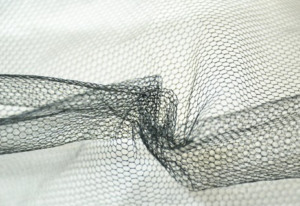 Tulle is a light, airy fabric. Synthetic fibers, intertwined with each other, form a transparent mesh with uniform cells.
Tulle is a light, airy fabric. Synthetic fibers, intertwined with each other, form a transparent mesh with uniform cells.
The history of creation begins almost 200 years ago. American fashion designers suggested using thin fabric for sewing ballet tutus and “tutu” skirts - the uniform of dance schools.
Tulle differs from other mesh options in its smoothness and uniformity. Its small cells look like rows of “honeycombs”. The material is very thin and light, its density is from 15 to 40 grams per 1 square meter. m.
There are several types of tulle:
Nylon thread gives strength and elasticity, which allows you to form lush designs of folds and flounces. By experimenting and adding spandex thread to the composition, manufacturers achieved a “knitted” effect.
Tulle does not like high temperatures and can melt when ironed.Experts recommend using fire-resistant fabric from American and European manufacturers for sewing clothes. It does not flare up instantly, but smolders.
Tulle is stain-resistant, lightweight, does not fray, does not stretch when sewing, and does not require additional processing of seams. Synthetic fabrics have one big drawback. Several layers can create a “greenhouse effect”.
1. In appearance:
2. By color:
3. According to release form:
Tulle is a material that can give a holiday. It will add a special charm to anniversaries and weddings, spontaneity to a children’s party, and mystery to a carnival. It all depends on the skill and imagination of the designer.
Soft and medium-hard material is used for sewing wedding and evening dresses, carnival costumes, and children's outfits.
Hard and medium - when decorating the interior. Draping windows, walls, stairs, decorating the perimeter of tables, decorating chairs.
Hard tulle is used in the manufacture of filters and mosquito nets.
Professionals and novice craftsmen use tulle to decorate bouquets, gifts, and make accessories and hair decorations. Needlewomen use it as a basis for embroidery and scrapbooking.
Proper care.
The characteristics of tulle indicate the practicality of the material. No special care skills are required.
It is recommended to store dresses at home in a closet, on a hanger, after straightening out the creases. You can put a roll of a towel in the sleeves. The edge should hang freely.
Before washing, remove all sewn or pinned decorations. Wash by hand in warm soapy water.
Important! Do not twist the fabric! Wait until the water drains and rinse several times. To prevent electrification of synthetics, add a little conditioner at the last rinsing stage. Then hang, straighten, and leave to air dry. Avoid drafts.
Machine washable, subject to several rules:
Removing creases and folds.
Tulle dresses are not clothes for everyday use. At home you have to store it in a cramped closet. The result is the formation of unsightly folds and creases. There are several ways to give a product a neat look.
1. Steam treatment.
The fastest and most effective method. Hang the dress on a hanger, placing it at a sufficient height from the floor. Run the steam generator several times over large parts, then over the sleeves and collar. In places of strong creases, repeat the procedure.
2. Ironing.
It takes time and accuracy. It is necessary to iron the fabric at a minimum temperature through gauze, after making sure that the soleplate of the iron is clean. To prevent stains, it is not recommended to steam or spray with water. First iron the bodice and sleeves of the dress. Then - separately each layer of the skirt, starting with the inner one.For small parts, use a special tool or place a tightly rolled towel.
3. In the bath.
The safest and most gentle straightening method. You need to draw a bath of hot water and wait until the room is filled with steam. For some time, from 30 minutes to 2 hours (depending on the volume), leave the outfit on a hanger over a hot bath.
4. In the kitchen.
If you need to straighten small parts, then using a bath is not advisable. The best option is to hold the products over a saucepan or kettle of boiling water.
5. Using a hair dryer.
Using a spray bottle, lightly spray the surface of the material and dry with a hairdryer, setting it to medium power. If the crease remains as a result, repeat the procedure from the beginning. The hot air flow will act on the principle of a steam generator.
Tulle is widespread in modern fashion. Delicate and weightless, it is able to create a fairy tale at any holiday and bring romance into everyday life.